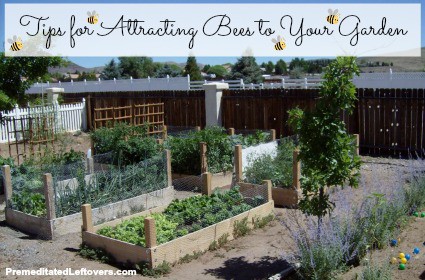Here are some tips for attracting bees to your garden.

Last year as I was perusing the blogosphere looking at gardens, I repeatedly read of gardeners complaining about the lack of bees in their garden. Their plants were healthy and flowering, but they were not producing fruit. I thought I would share some of the ways I attract bees to my garden.
Tips for Attracting Bees to Your Garden
Want more bees in your garden? Here are tips on how to attract bees to your garden including planting early blooming plants, attracting mason bees, growing a variety of bee-friendly plants so you have something in flower from early spring through fall.
Plant large groups of flowering plants.
A large grouping of flowering plants will encourage bees more than individual bushes will. I planted “walls” of flowers around my raised garden beds and throughout the backyard to attract bees to the area. I planted my raspberries, blackberries, and gooseberries in front of a wall of honeysuckle and my strawberries are planted under a flowering tree.
Stop spraying weed and insect killers on your grass!
Dandelions and clover attract bees. Plus you can use the dandelion greens in salads and the dandelion and clover blossoms to make tea. Food for you and the bees; it’s a win-win.
Add fruit trees to your landscaping.
We have apple, pear, and plum trees in our backyard. They blossom before many of our other plants drawing the bees to our yard early in the season.
Include a variety of flowering vegetables in your garden.
I mostly grow salad greens, cruciferous vegetables, and root vegetables in the spring which are all harvested before they flower. So I add a variety of early flowering vegetables such as peas and green beans to my spring garden to ensure that I have something to attract the bees so they will stick around for later in the season when the squash, melon, eggplant, peppers, and tomatoes begin to bloom. Growing a variety of vegetables that blossom at various times throughout the growing season, will encourage bees to continue visiting your garden.
Attract Mason Bees to your yard.
I encourage mason bees to come live on our property because they are less aggressive than honey bees. If you are interested in attracting mason bees, you can build a Mason Bee House. If you don’t feel like building one, you can buy a Mason Bee House for less than $20.00.
Grow a variety of bee-friendly plants.
Here are some of my favorite bee-friendly plants, but you should check your local agriculture department to find out what plants your native bees prefer. You want a variety of plants that flower throughout the year to provide the bees with a diversity of nectar from spring to fall.
Early Spring Blooming Plants
- Crocus
- hyacinth
- Strawberries
- Snapdragons
Late Spring Blooming Plants
- Blueberries
- Raspberries
- Honeysuckle
- Lavender
- Cat Mint
Early to Mid Summer Blooming Plants
- Bee Balm
- Butterfly Bush
- Sunflower
- Cosmos
Late Summer to Early Fall Blooming Plants
- Russian Sage
- Chrysanthemums
If the bees just won’t show up, you can Google “how to hand pollinate________” (insert the name of the plant you want to hand pollinate). You will find quite a few sites, some of which include video demonstrations.
Plants to Avoid Planting when Attracting Honey Bees
Rhododendrons, Mountain Laurel, and other plants in the Rhododendron family produce grayanotoxin, a natural compound that has toxic effects. Azaleas are closely related to Rhododendrons and produce similar toxicity. Yellow Jessamine is another plant that can be toxic to honey bees.
More Gardening Tips:
DIY Frugal Cloche
How to Make Raised Garden Beds
How to Extend a Short Growing Season
DIY Planter from a Tree Stump
How to Make a Mini-Greenhouse with Recycled Items
How to Make Fast and Easy Compost Pile Using Hay Bales
Extend Your Growing Season with a Container Garden
How to Get More from Your Square Foot Garden with Succession Planting
This article was first published on May 24, 2015. It was updated on January 26, 2022.


obearlady says
do you have any tips on how to keep deer ( i got 25 head here )a way or grown chipmunks away in the garden ?